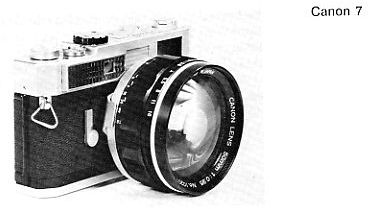

Canon 7 and 7S
The most important feature of these cameras is that they can accept the 50mm f/0.95 lens. This superfast lens extends photography to the realm of �available darkness.� Another difference between these models and their predecessors is the built-in exposure meter. All the thread mount lenses of the other Canon rangefinders can be used with the Canon 7 and 7S, but the f/0.95 lens cannot be attached to any other Canon camera. The basic operations of the Canon 7 and 7S are identical with the other Canon rangefinder.

Canon Pellix
The Canon Pellix differs from any other single-lens reflex system by its half transparent, non-moving mirror. This mirror reflects about one-third of the light passing through the lens upward into the finder, while the other two-thirds of the light is projected onto the film plane. Of course, the meter takes into account the 33 per cent loss of light used for viewing.
When exposure is made by the self-timer and there is no one behind the camera to block light from entering the eyepiece, the extra light could affect the meter reading, therefore the camera is equipped with an eyepiece shutter. A rubber eyecup is strongly rec�ommended for normal picture-taking situations, not only with this camera, but with any through-the-lens metering SLR, because the penetrating stray light may falsify the findings of the photocells. Eyeglass wearers should be particularly aware of this situation. In�stead of wearing eyeglasses while shooting, the appropriate strength of eyesight-adjustment lens should be attached to the frame of the rubber eyecup.
� Christian Rollinger 2002